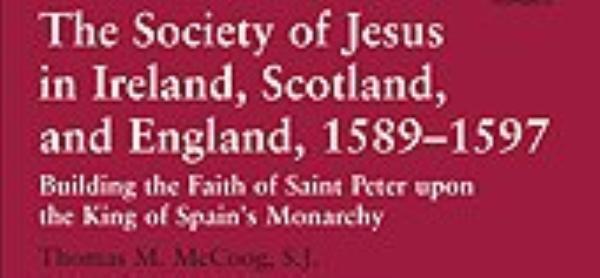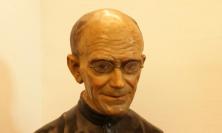Several decades ago, an Anglican clergyman surprised me by saying that, ‘As late as the 1620s, England could have been reconverted to Catholicism.’ His originality was impressive, but I wondered about the accuracy of his scholarship. Father McCoog’s book shows us that the Catholic cause was lost long before the reign of Charles I. Jesuits, who laboured and suffered under Elizabeth I and James VI, could not have realised that their heroic efforts would have only a very limited success and that the two British kingdoms were set firmly on a Protestant course. English Jesuits found plenty of residual Catholicism that gave hope for the future; their Scots brethren had to work against remarkable odds. Irish Jesuits, in the years studied here, were few in number and spent most of their lives overseas, but were encouraged by growing support from home.
Father McCoog’s book, based on a very close study of a vast number of documents, looks at Jesuit mission work in the three kingdoms. The documents are preserved in many repositories, but the most important collection is in the great Jesuit Archive in Rome (the ARSI or Archivum Romanum Societatis Iesu). Saint Ignatius of Loyola established the Jesuit custom of reporting to the Superior General, and of seeking his advice and that of his counsellors. Rome was thus very well informed about events in the three kingdoms.
Father McCoog is Archivist of the British Jesuit Province and has spent many years as a member of the Jesuit Historical Institute in Rome. His knowledge of the period is unrivalled, so he provides us with as much background knowledge as we need to understand the documents that he analyses in each of the six chapters. The range of the topics is comprehensive: Life on the Mission; Catholic Exiles on the Continent; Treasons, Plots, Conspiracies and Martyrdoms; Conflict and Discord on the English Mission; Continental Struggles. When reading each chapter, it is best to read the introduction and the conclusion before reading the other sections, which are supplied with excellent sub-headings. This allows a reader to approach each topic with confidence. There is a certain amount of repetition, but this is necessary to anchor each chapter. There are many nuggets of information in the detailed footnotes. This is a book written by a scholar for scholars.
Studies of Post-Reformation Catholicism in these islands have been segmented; historians have given a lot of attention to England and considerably less to Scotland. This reflects the relative importance of the two kingdoms and the size of their Catholic populations, but recent scholarship looks for connections between Ireland and Britain, realising that the three kingdoms share much history. The Irish story is complicated by the changes in Elizabethan policy: the gradual advance of the English conquest of the whole island came from the English realisation that confiscation of land, plantation of English Protestant settlers and the use of unlimited terror against Gaelic Irish Catholics would all be necessary if the Queen’s smaller kingdom were to be subdued. Anti-Catholic legislation could not be enacted in Ireland, because the Irish Parliament, which had a large Catholic membership, would not pass it, so Irish Catholic martyrs were tried under martial law. Some English Catholics, such as the Browne family (later earls of Kenmare), moved to Ireland, because their lives would be much easier.
Edmund Campion is more attractive a personality than any other Jesuit of Elizabethan England, but this book takes us into years that are post-Campion and post-Armada. We spend a lot of time in the company of Robert Parsons SJ and his friend Cardinal Allen, becoming well acquainted with both of them. Parsons was gifted, courageous, tireless and uncompromising. Like Allen, and many others, he placed his hopes on Spanish aid and a Spanish invasion. He won the trust of Philip II of Spain and of leading Churchmen, but he was feared and hated by many of his fellow countrymen: he was loyal to his faith, but not to his Queen. For many others, the choice would not be so clear, leaving English Catholics in a dilemma that endured for centuries. Only at the very end of the 1590s, when a Catholic monarchy was firmly established in France, could English Catholic exiles begin to consider that Spain might not be their only Continental friend. Spanish help, however, was vital to the survival of British and Irish Catholicism, because Philip II and his successors provided refuge, financial aid and political support.
The Jesuit (and other) documents record the constant struggles of English Catholics and the vile treatment they received from their monarch and her government. They could expect no improvement as they endured what Edith Sitwell, following a suggestion of Philip Caraman SJ, called The Other Face, because Queen Bess was less than ‘good’ to Catholics in England and Ireland, for whom her days were not ‘golden’.
Father McCoog shows us that the plight of Scots Catholics was even worse, because there were fewer of them and because they were scattered. He records the struggles of James VI with the fractious nobility and the willingness of Jesuits to believe that the wily monarch, who had been baptised but not brought up as a Catholic, might be Catholic at heart. ‘Noble’ was an oxymoron when applied to many of the Scots nobility. The Kirk, being as preoccupied with persecution as it was with predestination, does not emerge well from these pages. James was able to convey all sorts of impressions, whilst committing himself to nothing.
After more than four centuries, there is residual pain in reading about the ‘Wisbech Stirs’. The divisions between Jesuits and some secular priests imprisoned in a Cambridgeshire castle developed suddenly and became very bitter in 1594-95. The government was happy to foment discord. The legacy of the ‘Stirs’ endured into the late 20th century.
Exiles quarrel and are often unwelcome in the countries where they are obliged to live. English and Irish Jesuits were not greeted with open arms by fellow Jesuits in countries where they founded colleges, which competed with existing Jesuit colleges for donations and benefactors. Despite this local hostility, the seminaries founded by the English at Valladolid (1589) and the Irish at Salamanca (1592) were to be the first in a network of colleges in the lands of the Spanish Crown and in Rome, which were vital to the provision of well-trained priests in the three kingdoms. The foundation of a Jesuit school at Saint-Omer in 1593 was the beginning of a story that continues in Stonyhurst College to this very day.
This was a period in which the Society of Jesus was increasing yearly in membership; the number of Jesuits trebled during the Generalate of Claudio Aquaviva (1581-1615), with ever-more colleges, churches and missions. Within that broad context, the attention Father General gave to the small British and Irish missions (comprising only a few dozen men) was very impressive. He knew that those Jesuits could face martyrdom at any time. The Jesuit vocation was so attractive that Blessed John Cornelius admitted himself to the Society immediately before his martyrdom at Dorchester in 1594. Saint Nicholas Owen (martyred in 1606) must have done something similar, because Father McCoog can find no evidence that he was formally admitted to the Society. This book’s extensive account of Saint Henry Walpole’s interrogations is disturbing; he gave so much information about his colleagues and contacts that, despite the undoubted heroism of his martyrdom in 1595, one wonders if he should have been given a place amongst the Forty Martyrs of England and Wales.
Father McCoog concludes on a very sombre note: ‘Declared traitors by the crown, denounced by secular clergy, and derided by continental Jesuit colleagues, the English Jesuit mission was beleaguered by late 1590s.’ (p. 418) Its survival and remarkable recovery could not have been foreseen.
The reviewer, Fergus O’Donoghue SJ is the Archivist of the Irish Jesuit Province.
![]() Find this book on Ashgate's web site
Find this book on Ashgate's web site
![]() Shop for this book on Amazon, giving a 5% cut to the Jesuit Refugee Service, UK
Shop for this book on Amazon, giving a 5% cut to the Jesuit Refugee Service, UK






